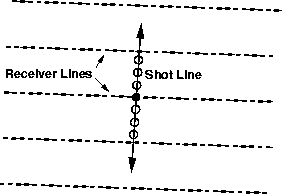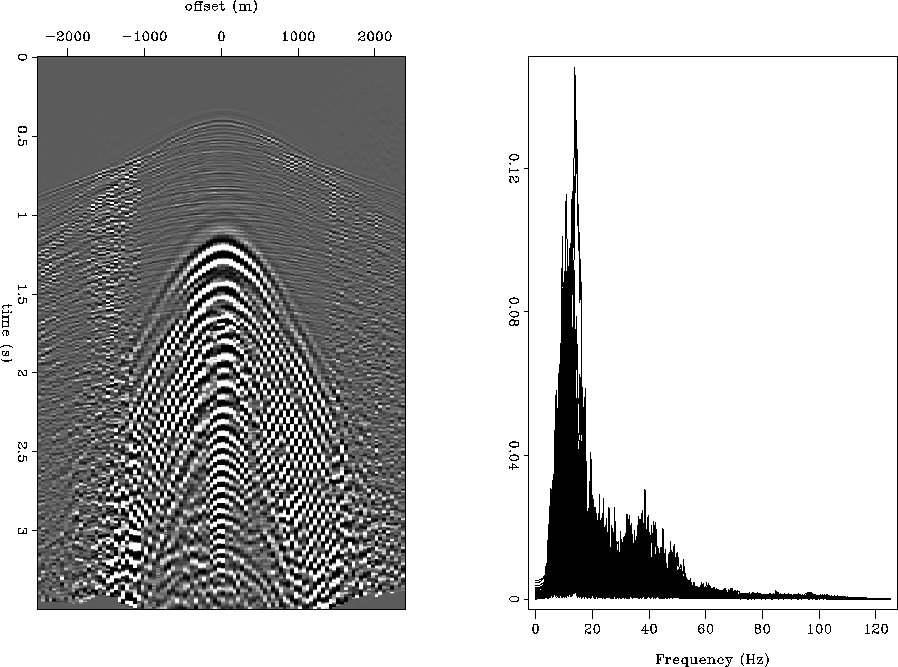|
cross-spread
Figure 1 So-called ``cross-spread'' 3-D land acquisition geometry. The spacing between the parallel receiver lines is much greater than the inline receiver spacing. |  |
In (t,x,y) space, the ground roll falls nearly within a cone centered at the shot location. Traditional 2-D roll-along land surveys consist of a single receiver line with a shot in the center, such that the recorded ground roll lies at the apex of the cone and has nearly linear moveout. In 3-D surveys, the ground roll on a 2-D receiver line has hyperbolic moveout when there is crossline distance between the shot, as in the common ``cross-spread'' acquisition geometry, shown in Figure 1. A single 2-D receiver line from a 3-D shot gather from such a geometry is shown in Figure 2.
In many cases, regions containing ground roll are simply muted from the recorded data, since they are localized in t-x. Clearly, however, it is preferable to use both the near and far offsets, rather than trying to ``outrun'' the ground roll by recording at very far offsets. High acquisition cost or geological considerations may prevent the recording of far-offset reflections, especially for deep targets. Likewise, multicomponent seismic applications such as the determination of fracture orientation and shear wave extinction angles Li and Mueller (1997); Mueller (1992), and also quantitative inversion techniques require both near and far offsets. Furthermore, as noted by Regone 1997, in regions of rugged topography, body waves sometimes convert into surface waves after scattering from near surface heterogeneities, creating a high velocity event that reaches into the far offsets. The need to adaptively identify and nondestructively filter ground roll is pressing, but the geographical variability of near surface geology gives ground roll wildly variable character, and prevents most current techniques of removal from achieving universally applicability.
|
cross-spread
Figure 1 So-called ``cross-spread'' 3-D land acquisition geometry. The spacing between the parallel receiver lines is much greater than the inline receiver spacing. |  |
 |
In spite of a long and successful tradition in ground roll suppression, field arrays often damage the recorded signal. Averaging operations imply an inherent loss of information, which in this case is the frequency content, and hence the resolving power, of the recorded signal. Incident primary reflections are never perfectly vertical, nor is the near surface perfectly laterally invariant, so a field array stack will always blur the wavelet. When the static shifts caused by near surface heterogeneities are strong, the blurring is significant. Often, as with Ocean Bottom Cable (OBC) or smaller-scale seismic applications, placement of arrays with adequate areal extent is impractical for logistical and/or economic reasons. Furthermore, traditional 2-D field arrays are ineffective in removing out-of-plane backscattered energy, so in many cases a 3-D array is required Regone (1997), adding considerably to the acquisition cost.
Often, as seen in Figure 2, ground roll occupies a much
lower frequency band than the primary reflections, in which case the ground
roll is easily removable by ![]() mute, at the expense of
the low frequency component of the signal, which is crucial for acoustic
impedance inversion Sbar and Blankenship (1998).
f-k (or ``fan'') filtering Treitel et al. (1967) is useful for removing
linear events, but is sensitive to aliased data, and ground roll is almost
always aliased at normal receiver spacing.
The aliasing becomes even more pronounced in 3-D, since acquisition costs
usually prevent adequate sample of the crossline.
mute, at the expense of
the low frequency component of the signal, which is crucial for acoustic
impedance inversion Sbar and Blankenship (1998).
f-k (or ``fan'') filtering Treitel et al. (1967) is useful for removing
linear events, but is sensitive to aliased data, and ground roll is almost
always aliased at normal receiver spacing.
The aliasing becomes even more pronounced in 3-D, since acquisition costs
usually prevent adequate sample of the crossline.
Ground roll and primaries normally differ greatly in moveout, so in that sense, the Discrete Radon Transform (DRT) can remove the ground roll in 2-D or 3-D. However, Marfurt et al. (1996) point out the extreme sensitivity of the DRT mute process to aliasing, so an a priori moveout correction to the ground roll is required, which in turn may cause aliasing of the primaries themselves. Additionally, the DRT is unable to remove backscattered energy from the crossline direction. Still, when the ground roll in a single 2-D receiver line is almost perfectly hyperbolic, as it is for instances of very well-behaved near-surface geology, the DRT may adequately separate it from the signal Wang (1997).
Canales (1984) introduced a fundamentally new view of the signal/noise separation problem. Rather than viewing noise as something to be explicitly subtracted from data, he exploited the fact that seismic signal is usually predictable relative to random noise. When a prediction error filter (PEF) is estimated from a given dataset, Gaussian noise components of the data are in the nullspace of the estimation. It is a known Claerbout (1976) that the frequency response of a PEF approximates the inverse spectrum of the data from which the PEF was estimated. By computing a PEF (f-x domain) from the noise-contaminated data, this approach obtains an ``in situ'' estimate of the signal power spectrum. Application of Wiener reconstruction Castleman (1996) then yields an optimal (least squares) estimate of the signal.
Coherent noise suppression is a more difficult matter, since it requires an indirect method of estimating the signal PEF, like that of Spitz (1999), who presented a predictive f-x technique to suppress multiple reflections. We present a similar predictive signal/noise separation scheme in the t-x domain which utilizes recent SEP advances in nonstationary filtering, and apply it to the removal of complicated ground roll in 2-D receiver lines which come from a 3-D land survey. This approach requires only a rough model of the ground roll, obviating the need for explicit modeling techniques, which are generally complicated and very costly. Clapp and Brown (1999) have applied the same methodology to suppress multiple reflections in prestack marine data.